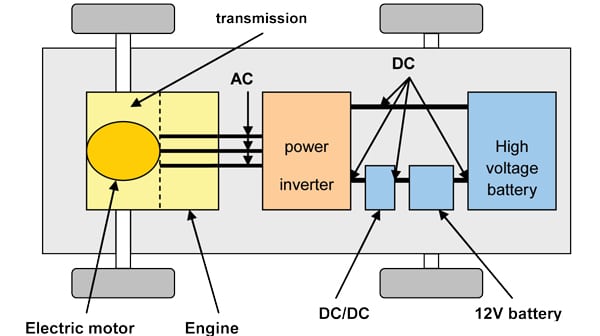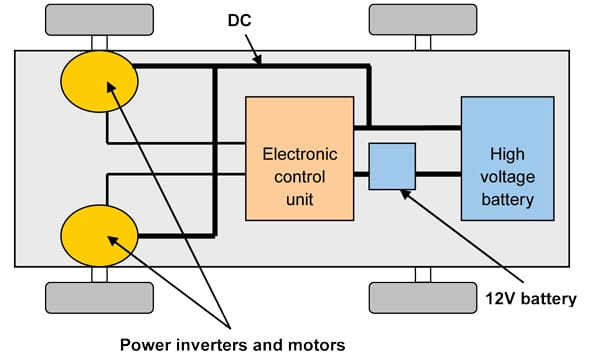Refinements are needed for better correlation between chip-level or module-level measurements and whole vehicle testing.
Michael Koffink and Roland Gubisch, Intertek Testing Services, Boxborough, Massachusetts, USA
The automotive EMC environment is in a constant state of flux as new onboard electric devices, communications media (both wired and wireless), and new drive systems are added. Consequently, both EMC standards writers and vendors find themselves in a situation without fixed, agreed-upon testing procedures for assuring the compatibility of vehicles and components in hybrid and all electric cars. Ongoing change is the only constant.
There are two opposing forces at work influencing EMC in the vehicular environment. The growing number of electronic components or modules for control, communications and entertainment now being installed make achieving EMC far more demanding. A second force promising to bring the situation under control is the trend to replace complex vehicle wiring carrying analog, digital, and high-current signals with simpler, low-power signaling protocols.
Between these two forces, engineers are modifying their predictive tools to keep up with changes at all levels—integrated circuit EMC evaluation, module EMC prediction, and measurement, and whole vehicle characterization. As circuits operate at higher frequencies (and voltages), simulation methods must adopt smaller grids for the accurate prediction of the resulting electromagnetic fields.
As this process of modification is underway, the vehicle manufacturers need to assure that new modules have been tested to their respective EMC standards correctly and that the standards reflect the actual environment of future installation. While many vehicle EMC standards are non-governmental (and/or OEM specific) and therefore simpler to update, in the European Union the Automotive EMC Directive 2004/104/EC contains its own requirements and is therefore more cumbersome to amend. Fortunately, it contains a number of international EMC standard references. Newer, independent manufacturers are starting to review their own EMC procedures and may see themselves developing their own standards.
HISTORY
The popularization of the car radio in the late 1920 was the “canary in the coal mine”—the proverbial early warning—that automotive EMC would be an ongoing challenge. By the 1930s a number of brands of commercial radios were available. The early models were AM (amplitude modulation) only and very susceptible to both ignition noise and static buildup from the car’s tires. Both sources of disturbances were quickly overcome. Spark plug suppression was provided by resistive cables and resistive plugs; research on optimum spark plug suppression continued into the 1970s . Conductive carbon was added to the car tires to prevent electrostatic charge buildup. In 1947, SAE J551, the first SAE (Society of Automotive Engineers) EMC standard, was published, but it was not until the proliferation of vehicular electronics in the 1970s that the development of further vehicle EMC standards occurred.
THE CHANGING EMC ENVIRONMENT
Today’s motor car contains an amalgam of legacy electrical/electronic functions and more recent devices—literally dozens of components or modules, sensors, and actuators, and more than one network. Table 1 lists typical functions and their attributes.

Each of these functions exists in, and also changes, the vehicle EMC environment. For example, all of the control systems add to network/bus noise. Also, the communications, entertainment, and security systems introduce radio sources while the GPS (global positioning systems) and satellite radio receivers require very low RF noise over their operating bands.


Compounding these EMC challenges from added electronic functions are the new factors associated with Hybrid Electric Vehicles (HEVs) and Electric Vehicles (EVs). Specifically, these include bus voltages exceeding 200 V, power inverter switching noise, and new bus/cable configurations. These issues are illustrated in the propulsion system block diagrams in Figure 1 and Figure 2 for HEV and EV configurations.
In addition to the basics shown in these figures, there are the myriad modules, sensors, actuators, networks, and central control for the vehicle.
CHANGING EMC TEST REQUIREMENTS
Existing EMC whole vehicle and module test standards cover the range of electromagnetic phenomena in conventional vehicles . Vehicle manufacturers have adopted SAE and international standards to varying degrees and have established their own EMC standards that the testing laboratory must follow closely. Table 2 summarizes some of the relevant standards by reference number.

Because of the high cost of performing whole-vehicle EMC testing and the need to expedite component integration, EMC testing is being performed at both the component or module and chip levels. The results are then used to predict compliance of the whole vehicle. Even without the added complexities of new HEV and EV propulsion systems, there are difficulties inherent in the existing test methods. At the chip or IC level, test standards such as the IEC 61967-x family and SAE J1752/3 do not fully predict installed EMC. The correlation between near and far field emissions may not hold, and the result is highly dependent on any external wiring harness. Also, at the module or component level, similar ambiguities exist. Component testing, however, can still be useful for identifying potential EMC problems.
The introduction of HEV and EV propulsion systems clearly intensifies the challenges to existing test methods even more. High battery voltages reduce power emission losses, but the resulting high system impedances can render invalid emission test results obtained with the artificial networks described in CISPR 25 . Battery and drive motor impedance and impedance changes can also become an important factor in EMC. Worst-case RF emissions from vehicular power converters have been observed under transient conditions of load and speed . Unfortunately, measurement standards have not yet taken this observation into account.
SUMMARY
Although automotive EMC standards are well-established by manufacturers, domestic and international standards-making bodies, refinements are needed to achieve better correlation between chip-level and component- or module-level measurements and whole vehicle testing. New HEV and EV drive systems add further challenge to automotive EMC testing.
REFERENCES
1. Burget, R.R. et al., “Relationship Between Spark Plugs and Engine-Radiated Electromagnetic Interference,” IEEE Transaction on Electromagnetic Compatibility, August 1974, pp. 160–172.
2. Anderson, Poul and Kimball Williams, “An Overview of Automotive EMC Standards,” IEEE EMC 2006 Symposium Proceedings, pp. 812–816.
3. Nelson, Jody J. et al.,“High Voltage Automotive EMC Component Measurements Using an Artificial Network,” Proceedings of the 18th International Zurich Symposium on EMC, 2007, pp. 195–200.
4. Nelson, Jody J. and Martin Aidam, “HEC System EMC Investigation During Transient Operations,” Proceedings of the 18th International Zurich Symposium on EMC, pp. 205–208.
ABOUT THE AUTHORS
Mike Koffink is the EMC Operations Manager and Roland Gubisch is an EMC Consultant for Intertek Corporation. They work for the Commercial & Electrical division of Intertek, which provides testing and certification services, including product safety testing and certification, electromagnetic compatibility (EMC) testing, and performance testing. Visit www.intertek-etlsemko.com for further information or to contact your local Intertek office.




